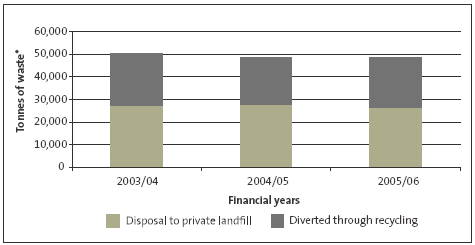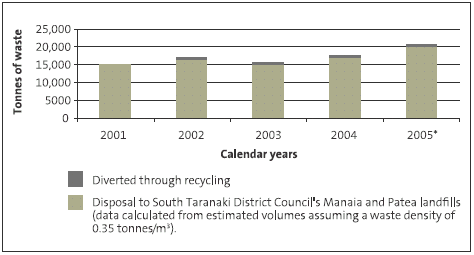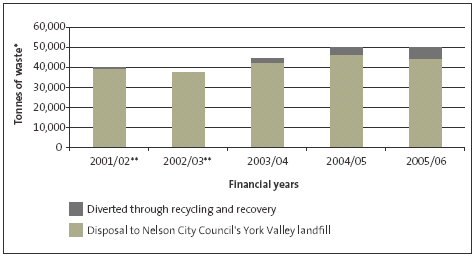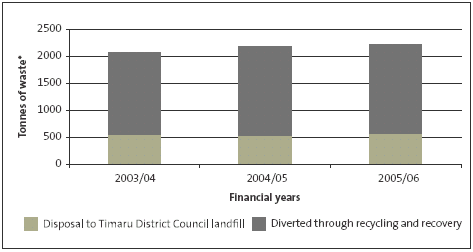Part 3: Waste management plan implementation by six selected authorities
3.1
In this Part, we discuss how six selected territorial authorities implemented their waste management plans. This includes:
- how we conducted this part of the audit;
- the individual territorial authorities' waste management activities;
- progress by the territorial authorities in implementing waste management plans;
- how the territorial authorities provided for the implementation of the plan through their LTCCP;
- the territorial authorities' progress in reducing or diverting the amount of waste going to landfills;
- the territorial authorities' collection of data on waste;
- how the territorial authorities reported on their waste management activities; and
- our conclusions.
How we conducted this part of the audit
3.2
We selected six territorial authorities so we had an example of an urban, provincial, and rural authority in each of the North and South Islands, giving a cross-section of sizes throughout New Zealand. The authorities we selected were:
- North Shore City Council;
- Rotorua District Council;
- South Taranaki District Council;
- Nelson City Council;
- Mackenzie District Council; and
- Queenstown-Lakes District Council.
3.3
We reviewed each council's progress in implementing its waste management plan by:
- reviewing council documents;
- interviewing staff and one or more councillors from each council; and
- visiting the waste management facilities of each council and council contractors.
Individual council waste management activities
3.4
The six councils had all prepared waste management plans. We summarise each individual council's progress in implementing the plans in paragraphs 3.6-3.30.
3.5
Figures 7-12 show the quantity of waste that each council managed itself or through contract arrangements. Some of the councils owned their landfills. These councils directly managed a larger proportion of waste in the district than councils without landfills, because the landfills accepted waste from private operators as well as any waste the council collected. The councils also collected waste data differently, so Figures 7-12 cannot be easily compared.
North Shore City Council
3.6
North Shore City Council adopted its current waste management plan in 2005, and had started implementing it. The plan was an update of its 2001 waste management plan.
3.7
The council had contracts, resources, and a small number of assets in place to provide for waste collection, recycling, and disposal. It had investigated waste recovery options.
3.8
Education activities comprised a significant part of the council's waste management programme. Activities included programmes1 to encourage efficient use of resources, including reducing the waste generated by businesses and the construction industry. Its EnviroSmart® district programme and subsequent North Shore City Council-led regional EnviroSmart® programme had been expanded into a national programme2 to improve business environmental performance and efficiency in resource use.
3.9
The council also had education programmes to encourage the diversion of waste through recycling and recovery.
3.10
The council measured how much waste it collected for recycling and disposal. We show this in Figure 7. The council adopted a bylaw in 2005 to enable it to gather information about the quantity of waste managed by private waste operators in the district.
3.11
There are no landfills operating in the North Shore district, so any residual waste must be transported outside the district for disposal.
Figure 7
Waste quantities managed by North Shore City Council

*This does not include waste managed by private operators within the district.
Rotorua District Council
3.12
Rotorua District Council adopted its waste management plan in 1999. In 2004, it reviewed its implementation of the plan and prepared a detailed review document.
3.13
The majority of programmes in the waste management plan were in place. The council had contracts, resources, and assets in place to provide for waste collection, reuse, recycling, recovery, treatment, and disposal.
3.14
The council had set up education programmes that encouraged waste diversion and, to a small extent, waste reduction. It had a waste education centre.
3.15
The council measured how much waste it collected for recycling, recovery, and residual disposal. It also measured how much waste was disposed of in its Atiamuri landfill, which accepted waste only from within the district. Figure 8 shows the quantities of waste managed by the council.
Figure 8
Waste quantities managed by Rotorua District Council

South Taranaki District Council
3.16
South Taranaki District Council adopted its waste management plan in 2000, and was in the process of preparing a new plan. It was a party to the Taranaki Regional Waste Strategy, which was prepared by the region's territorial authorities and the Taranaki Regional Council. South Taranaki District Council had done much of the work in its waste management plan. Some activities had been done with other councils and the Taranaki Regional Council through a regional working party.
3.17
South Taranaki District Council had assets, a contract, and resources in place to provide for waste collection, reuse, recycling, recovery, and disposal. It had recently changed its systems for collection and recycling. It was preparing for changes to disposal activities.
3.18
The council conducted waste education activities jointly with other councils in the region. Its education activities focused on waste diversion.
3.19
The council measured how much waste it collected for recycling and disposal. Figure 9 shows the quantities of waste going to landfills and diverted through recycling.
Figure 9
Waste quantities managed by South Taranaki District Council

* Waste disposed of to the landfills is estimated from data collected for the 2005/06 financial year.
Nelson City Council
3.20
Nelson City Council prepared its first waste management plan in 2001. It adopted a subsequent plan in 2005.
3.21
The council was implementing its plan. It had assets, contracts, and resources in place to provide for collection, reuse, recycling, recovery, treatment, and disposal. It had spent some time setting up a domestic kerbside recycling programme and was looking at options for diverting more organic waste from landfills.
3.22
The council was setting up a waste education programme to encourage waste diversion.
3.23
The council measured how much waste it collected for recycling and recovery. It also measured how much waste was disposed of in the council-owned York Valley landfill.
3.24
Nelson City Council's York Valley landfill and Tasman District Council's Eves Valley landfill are close to each other. Nelson City Council staff told us it was difficult to predict how much waste the York Valley landfill would receive each year, as private operators from both districts could dispose of waste at either site. Figure 10 shows the amount of waste going to the York Valley landfill, and the amount diverted through recycling and recovery.
Figure 10
Waste quantities managed by Nelson City Council

* The waste going to the landfill may come from within or outside of the district.
** A small amount of waste was diverted in these years.
Mackenzie District Council
3.25
Mackenzie District Council adopted a waste management plan in 1999. It had largely implemented its waste management plan, and had well-established assets, contracts, and resources for waste collection, reuse, recycling, recovery, and disposal.
3.26
The council employed a waste minimisation officer to deliver education activities. These activities focused on diverting waste.
3.27
The council measured how much waste was collected for recycling, recovery, and residual disposal. It also measured how much waste was managed by private operators in the district. Figure 11 shows the quantities of waste managed by the council that went to a landfill or was diverted through recycling and recovery.
Figure 11
Waste quantities managed by Mackenzie District Council

* This does not include waste managed by private operators within the district.
Queenstown-Lakes District Council
3.28
Queenstown-Lakes District Council adopted its first waste management plan in 2003 and was progressively implementing the plan. It had contracts and assets in place for collection, reuse, recycling, recovery, and disposal. It had further work to do in setting up recycling and recovery activities. In 2006, the council prepared a report that detailed its progress in implementing the waste management plan.
3.29
The council had a small number of waste education initiatives to encourage waste diversion.
3.30
The council measured how much waste it collected for disposal and recycling. It had a joint arrangement with Central Otago District Council for disposing of waste in the Victoria Flats landfill in the Queenstown-Lakes district. Queenstown-Lakes District Council kept a record of the amount of domestic waste each council took to the landfill, and of the total commercial waste that went to the landfill from both districts. Figure 12 shows the total amount of waste going to the Victoria Flats landfill.
Figure 12
Waste quantities managed by Queenstown-Lakes District Council

* The waste going to the landfill comes from the Central Otago and Queenstown-Lakes districts.
Implementation of waste management plans
Progress in implementing waste management plans
3.31
All six councils had adopted waste management plans.
3.32
Nelson City, North Shore City, Queenstown-Lakes District, and Rotorua District Councils were making steady progress in implementing their waste management plans.
3.33
Mackenzie and South Taranaki District Councils prepared their waste management plans some time ago. Their plans included methods to set up waste diversion systems, and they had done that. South Taranaki District Council was preparing a new waste management plan.
3.34
We were pleased to see that all six councils had implemented or were implementing their waste management plans.
3.35
Territorial authorities need to make sure that waste management plans are relevant to current and planned waste management activities and decisions.
Reviewing plan implementation
3.36
Most of the six councils had reviewed their progress in implementing waste management plans. They had used this information to better focus waste management activities, and in some cases used it to prepare new waste management plans.
3.37
The detailed review documents prepared by Queenstown-Lakes and Rotorua District Councils clearly identified the actions they had taken to implement their plans, and noted issues and further considerations that had arisen in the course of implementing the plan.
3.38
In our view, it is good practice for territorial authorities to review their progress in implementing their waste management plans. This is a transparent means of assessing:
- whether the plan is relevant and useful;
- what work in the plan has been done and what actions still need to be completed or are ongoing;
- the suitability of methods, objectives, and targets in the plan; and
- how waste management plans and activities can be improved.
Providing for implementation of the plan through the long-term council community plan
3.39
The LTCCP is the main mechanism each territorial authority has for allocating resources to provide for waste management activities over the long-term. The LTCCP provides a basis for a territorial authority to be accountable to its community.
3.40
Waste management plans adopted by territorial authorities included the policies and activities they agreed to after consulting with their community.
3.41
We expected the LTCCPs to include information about waste management activities that was consistent with waste management plans. We also expected each LTCCP to contain a summary or copy of the waste management plan, as the Local Government Act 2002 requires.
Findings
3.42
All six councils included a summary or copy of their waste management plan within the LTCCP. Several could have provided clearer summaries. One summary was inconsistent with the council's waste management plan. In our view, others did not convey the main messages or policies from the relevant waste management plan.
3.43
For all six councils, the LTCCP included information about waste management activities and made financial provision for them. However, it was difficult in several cases to tell whether the activities in the LTCCP were intended to implement waste management plans because:
- the LTCCP did not describe the waste management services or activities the council would provide or perform;
- the LTCCP did not clearly link the waste management plan to waste management activities within the LTCCP; or
- the waste management plan was no longer relevant for some council waste management activities.
3.44
In our view, councils need to take more care integrating information from their waste management plan into their LTCCP. As the main accountability document, the LTCCP needs to reflect, albeit at a higher level, what the council has agreed to do in the waste management plan. If information in the LTCCP contradicts or is inconsistent with the waste management plan, it is not clear whether the waste management plan had been considered when the LTCCP was prepared.
3.45
Several LTCCPs and associated documents did not include all the information we expected about how the councils would assess changes in demand for waste services and the effect this would have on the capacity of a council's assets.
3.46
Territorial authorities must be able to assess changes in demand for waste services and whether any additional asset capacity will be required. They need this information to plan for future waste activities.
Progress in reducing or diverting waste from disposal in a landfill
3.47
As detailed in paragraph 1.10, the Local Government Act 1974 encourages territorial authorities to reduce waste generation in preference to diverting waste (through reuse, recycling, and recovery) or disposing of waste to a landfill.
Waste reduction
3.48
Most of the six councils were not actively seeking to reduce waste generated in their district. Instead, their focus was on managing waste through reuse, recycling, and recovery systems and on education, as well as disposing of the waste in landfills.
3.49
Reducing waste is an important waste management activity. It uses fewer resources and means there are smaller quantities of waste to manage. Figures 7-12 show that, in recent years, the total quantity of waste (that is, diverted waste and waste going to a landfill) managed by the six councils has remained steady or has increased.3
3.50
While data in this report show trends for only a short period of time, the data suggest that these councils – without intervention to reduce waste – can expect to deal with the same or increased quantities of waste in the future, whether they are disposing of waste in landfills or diverting it elsewhere.
3.51
Many of the councils advised us it was difficult to identify methods they could implement to reduce waste. Staff and councillors from several of the councils told us it was difficult for councils to reduce the quantity of waste generated on their own, and that leadership from central government was needed to address this issue.
3.52
We acknowledge that it is difficult for councils to reduce waste. We commend North Shore City Council for the initiative it has shown in preparing its EnviroSmart® programme to increase resource efficiency.
Diverting waste
3.53
All six councils had set up, or were setting up, facilities, contracts, and education initiatives to divert waste from landfills.
3.54
Mackenzie District, North Shore City, and Rotorua District Councils' waste diversion systems had been set up for some time. It was difficult to compare the three councils because they handled different quantities of waste and different parts of the waste stream, and gathered waste data differently.
3.55
All three councils showed good performance diverting waste. North Shore City and Rotorua District Councils were diverting significant quantities of waste from landfills, but Mackenzie District Council, dealing with smaller quantities of waste, diverted a high proportion from the landfill.
3.56
South Taranaki District Council had been diverting waste for some time, but it had recently changed its waste diversion arrangements. Nelson City Council had been diverting waste through recovery for some time, but had put recycling arrangements into place more recently. Queenstown-Lakes District Council was still setting up its waste diversion systems.
3.57
It was too early to comment on the diversion rates that South Taranaki District, Nelson City, and Queenstown-Lakes District Councils were achieving.
Expanding waste diversion systems
3.58
Rotorua District Council had expanded its waste diversion capabilities. This had been helped by the willingness of the council to do so and by the innovation of the contractor.
3.59
Nelson City and North Shore City Councils were considering further activities to divert particular parts of the waste stream from landfills, but were taking a cautious approach while they considered the cost and operational requirements of these activities. The activities they were considering were in accordance with their waste management plans.
3.60
Improving waste diversion performance, whether by refining existing systems or by introducing further diversion activities, can bring benefits to territorial authorities. We were pleased to see the councils were considering the costs and operational requirements of doing so.
Disposing of waste in landfills
3.61
Despite all six councils achieving some waste diversion, large quantities of waste continue to go to landfills. All the councils expected to continue disposing of waste in landfills for the foreseeable future.
3.62
If there is no reduction in waste and only limited diversion of waste, large quantities of waste will continue going to landfills. Territorial authorities need to consider carefully the sustainability of this approach and its effect on community well-being.4
3.63
All six councils held some information about the landfill capacity available to them. Some had done detailed work to determine this, while others had estimated it roughly.
3.64
In our view, if territorial authorities continue disposing of waste in landfills, they need to have a good understanding of available landfill capacity so they have enough time to make alternative disposal arrangements if it becomes necessary.
Management practices
Waste management skills
3.65
Setting up and operating waste management systems often require specialist knowledge. Territorial authorities therefore need to determine the skills required to deliver planned waste management activities, and to decide how they will provide this.
3.66
It is important for territorial authorities with contracts in place to ensure that it is clear who is responsible for managing the contract. Territorial authorities need to ensure that contract managers have appropriate skills, and that contract management systems are in place.
3.67
Most of the six councils employed waste management staff, and had multiple contracts and contractors for waste management activities. For most of these councils, it was clear who was responsible for managing the contracts.
Data collection
3.68
The quantity of waste that territorial authorities manage through their facilities and/or contracts is sometimes different from the total quantity of waste generated within the district. This is because some waste is managed by private operators.
3.69
All six councils collected detailed information about the quantity of waste they or their contractors managed. Several of the councils could improve their data management practices.
3.70
Most of the councils had set up, or were setting up, systems to measure or closely estimate the quantity of waste managed by private operators, so they could determine the total quantity of waste generated in their district.
3.71
It is important for territorial authorities to hold detailed information on the waste they manage. They need this to assess the cost-effectiveness of current waste management practices, and to forecast expected costs and asset requirements for future waste activities.
3.72
It is useful for territorial authorities to hold information on the total quantity of waste generated in the district (in some cases, this may be the same as the quantity of waste they manage). This enables them to determine trends in waste generation, the proportion of the waste stream they are managing, and the effect of education programmes on businesses and residents using private waste operators.
Internal reporting on waste management
3.73
The six councils provided some reporting to councillors on solid waste activities, many on a regular basis. Reporting from several councils clearly linked current waste management activities to their waste management plan. This is an effective means of demonstrating how activities contribute to implementing the waste management plan.
3.74
Some waste management activity reports intended for councillors were very technical, and their key conclusions and recommendations were not clear. Reports need to be coherent, be pitched for a suitable level for their audience, and clearly state the main messages and any recommendations.
Public reporting on waste management
3.75
The Waste Strategy suggests that territorial authorities report progress on waste minimisation and management on an annual basis, using quantitative measures.
3.76
All six councils reported on waste management activities in their annual reports. All recent reports included quantitative information. The nature of this information varied from report to report, and could not be compared easily across the councils.
Our conclusions
3.77
All six councils were implementing their waste management plans. However, most of their waste management activities were directed at dealing with the waste that was generated, rather than with reducing the quantity of waste generated.
3.78
If there is no reduction in the amount of waste generated, territorial authorities can expect to continue to manage steady or increasing quantities of waste. We are not convinced that all of the six councils understood the demand this would place on some aspects of their waste management activities in the future.
3.79
Current waste management practices and policies have a strong influence on the quantity of waste that territorial authorities can expect to manage in the future and the ultimate destination of this waste. We encourage every territorial authority to consider carefully the sustainability of the approaches within waste management plans, and their effect on community well-being.
1: For example, see www.rebri.org.nz.
2: See http://www.landcareresearch.co.nz/research/sustain_business/enviromark/envirosmart/.
3: We have not assessed whether the councils had determined the reasons for trends in the quantities of waste they managed. However, we reviewed 2001 and 2006 census figures to see whether the population in each district had changed. There has been less than a 5% population change in most of the districts, except for the North Shore City Council (11% increase) and the Queenstown-Lakes District Council (35% increase).
4: The term community well-being is used in this report in the context of the Local Government Act 2002, which provides for local authorities to play a broad role in promoting the social, economic, environmental, and cultural well-being of their communities, taking a sustainable development approach.
page top
